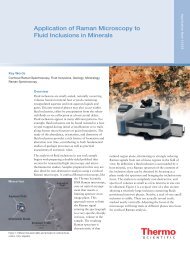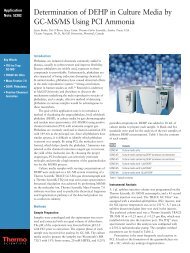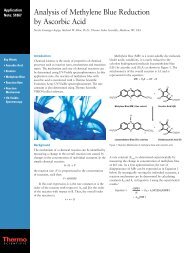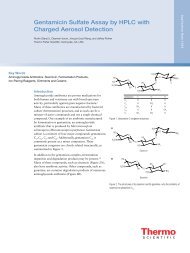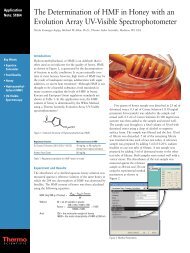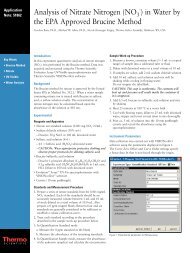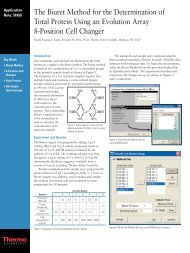Strategies for Coupling Nonvolatile Salt-Based HPLC to ... - Dionex
Strategies for Coupling Nonvolatile Salt-Based HPLC to ... - Dionex
Strategies for Coupling Nonvolatile Salt-Based HPLC to ... - Dionex
You also want an ePaper? Increase the reach of your titles
YUMPU automatically turns print PDFs into web optimized ePapers that Google loves.
The experimental workflow includes the following steps:<br />
• Separation of the analytes<br />
• Trapping of related compound in loop<br />
• Transfer of related compound <strong>to</strong> SPE column and<br />
removal of salts<br />
• Elution of related compound <strong>to</strong> MS<br />
The separation is moni<strong>to</strong>red with UV detection. Selection<br />
of the related compound can be per<strong>for</strong>med on retention<br />
time or by using a peak trigger based on the UV signal.<br />
The latter option has the advantage that retention time<br />
variation is accounted <strong>for</strong>.<br />
The LC and SPE systems are linked via a two-position<br />
switching valve with or without an additional sample loop<br />
<strong>to</strong> trap the related compound. The concept of in-loop<br />
trapping (column ➔ trapping loop ➔ SPE column ➔ MS)<br />
features some advantages compared <strong>to</strong> in-line trapping<br />
(column ➔ SPE column ➔ MS). The chroma<strong>to</strong>graphic<br />
method is independent of the SPE wash step and elution<br />
<strong>to</strong> the mass spectrometer. Also, the backpressure on<br />
the SPE column does not influence the LC per<strong>for</strong>mance<br />
(possible shift in retention times). In addition, this<br />
configuration maintains low backpressure on the UV flow<br />
cell as well as a low system pressure (see left valve,<br />
Figure 1). However, the loop dimensions must be<br />
carefully selected.<br />
USP <strong>HPLC</strong> Method <strong>for</strong> Related Compounds of<br />
Recombinant Insulin<br />
Sample:<br />
Recombinant human insulin<br />
3.75 mg/mL in 0.01 M HCl<br />
Analytical Column: Thermo Scientific Acclaim 120,<br />
C18, 3 µm, 4.6 × 150 mm<br />
SPE Column: Oasis ® 2.1 × 50 mm, 15 µm<br />
Solvents: (A) 0.2 M sodium sulfate,<br />
pH 2.3/ace<strong>to</strong>nitrile 82/18 (v/v %)<br />
(B) 0.2 M sodium sulfate,<br />
pH 2.3/ace<strong>to</strong>nitrile 50/50 (v/v %)<br />
Gradient: Time (min) % B<br />
0 24.5<br />
36 24.5<br />
61 64.0<br />
67 64.0<br />
68 24.5<br />
91 24.5<br />
Make-Up Liquid: Water<br />
SPE Elution: 80/20 ace<strong>to</strong>nitrile/H 2<br />
O + 1%<br />
<strong>for</strong>mic acid<br />
Flow Rates:<br />
Detection:<br />
Analytical column: 1.00 mL/min<br />
Make-up: 0.50 mL/min<br />
Elution from SPE column: 0.05 mL/min<br />
UV: 214 nm, 280 nm<br />
MS: 300–2000 m/z<br />
Ion-Exchange <strong>HPLC</strong> Separation of<br />
Ribonuclease A<br />
Sample: Approximately 0.35 mg/mL<br />
Ribonuclease A (1.75 µg injected)<br />
Analytical<br />
Column:<br />
SPE Column:<br />
Thermo Scientific ProPac SCX-10,<br />
2 × 250 mm<br />
Thermo Scientific Acclaim PepMap <br />
300 C18, 5 µm, 1.0 × 15 mm<br />
Solvents: (A) 20 mM MES + 60 mM NaCl, pH 5.6<br />
(B) 20 mM MES + 180 mM NaCl, pH 5.6<br />
Gradient: 55–85% B in 50 min<br />
SPE Elution: 80/20 ace<strong>to</strong>nitrile/H 2<br />
O + 1% <strong>for</strong>mic acid<br />
Flow Rates: Analytical column: 0.20 mL/min<br />
Make-up flow rate: 0.50 mL/min<br />
Elution from SPE column: 0.05 mL/min<br />
Results and Discussion<br />
Reversed-Phase <strong>HPLC</strong> Separation of Related<br />
Compounds of Recombinant Insulin<br />
Human insulin, a 5.7 kDa polypeptide, is used <strong>to</strong> treat<br />
some <strong>for</strong>ms of diabetes mellitus and is mainly produced<br />
through recombinant techniques. One of the release<br />
tests of human insulin is the quantification of related<br />
compounds. The United States Pharmacopeia (USP)<br />
has published a reversed-phase LC (RPLC) method<br />
<strong>for</strong> determining insulin and related impurities. A typical<br />
chroma<strong>to</strong>gram is shown in Figure 2.<br />
FIGURE 2. Separation of human insulin and compounds<br />
according <strong>to</strong> the USP method.<br />
5.8<br />
mAU<br />
0<br />
0<br />
Hydrophilic<br />
impurities<br />
Insulin<br />
Minutes<br />
A21 Desamido insulin<br />
(Main impurity)<br />
Hydrophobic<br />
impurities<br />
52<br />
In-Loop Trapping<br />
Transfer <strong>to</strong> SPE Column<br />
Wash SPE Column<br />
Transfer <strong>to</strong> MS<br />
2 <strong>Strategies</strong> <strong>for</strong> <strong>Coupling</strong> of <strong>Nonvolatile</strong> <strong>Salt</strong>-<strong>Based</strong> <strong>HPLC</strong> <strong>to</strong> MS Detection <strong>for</strong> the Separation and<br />
Characterization of Related Substances in Biopharmaceuticals<br />
25374



